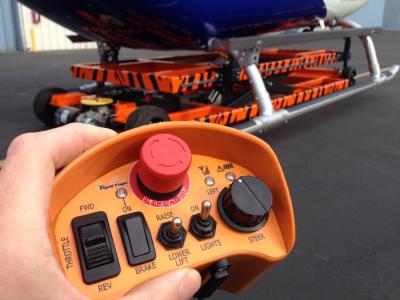When a New Zealand businessman needed to solve a unique transportation problem, he sought out a Bend (OR)company for help.
Tiger Tugs, a subsidiary of Cutting Edge Design Inc. in southeast Bend, recently finished work on a modified version of its standard remote-control helicopter tug. While standard Tiger Tugs can only move a helicopter forward and backward into a hangar, the new version, the Typhoon, can move in any direction. Steve Hill, founder of Tiger Tugs, said this will allow the New Zealand businessman to land a helicopter on his luxury yacht, and turn it sideways to fit it into an onboard hangar.
“It’s the only helicopter tug in the world that can do this,” Hill said Friday.
Cutting Edge Design was founded in 2007 as a metal fabrication company, but Hill said he founded Tiger Tugs in 2009, after the Great Recession took hold.
“We realized just the cutting and forming of metal in Bend wasn’t going to be sufficient,” Hill said.
Hill’s Tiger Tugs adjust more easily to accommodate helicopter skids than other tugs on the market, helping pilots avoid damaging their helicopters. Additionally, Tiger Tugs are controlled via a remote control, which allows one person to guide the vehicle. Hill’s customers include the U.S. Army and several corporations, as well as a handful of celebrities, including Paul Allen and Harrison Ford, who have bought tugs for their personal use.
“We’ve got (tugs) in New Zealand, Australia, Japan, China, Europe,” Hill said. “You name it, we’ve got them everywhere.”
While several customers, including Allen, have used Tiger Tugs on yachts in the past, the new project represents a different challenge. The buyer, who Hill would not identify specifically, has a helicopter hangar on his yacht that can only accommodate the helicopter by turning it to the side. Consequently, Hill said, the buyer has been looking for a product that can maneuver the helicopter to fit the yacht’s dimensions.
“You’ve now given them a way to move this helicopter to somewhere else on this deck,” Hill said.
He added that the buyer reached out about two years ago. Hill consulted with several advisers to come up with a couple of designs. The final product uses specialized rollers rather than traditional wheels, allowing the Typhoon to change direction without re-orienting itself. From design to painting, the process took about nine months to complete and will cost the buyer around $100,000, compared to around $30,000 for a standard Tiger Tug.
According to a report from the yachting industry company Camper & Nicholsons, there are 4,476 super yachts — yachts longer than 30 meters, or about 98 feet — in use today.
The Typhoon will be shipped by the end of this month, Hill said. Meanwhile, the buyer asked him to start work on another identical tug for his second yacht. Hill added that Vulcan Inc., an aviation company founded by Paul Allen, has reached out about building a similar product for his unfinished yacht, but a spokesperson from Vulcan would not confirm it.
Additionally, Hill said he’s seen interest in omnidirectional tugs from manufacturing companies and film offices, both of which require transporting heavy equipment around tight corners.
“We’re about maxed out on designs; we’re ready to just start building for a while,” Hill said.
—Reporter: 541-617-7818, This email address is being protected from spambots. You need JavaScript enabled to view it.

